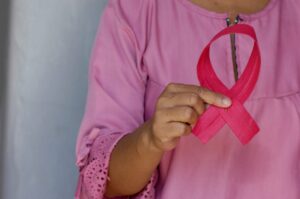
Whether it's Breast Cancer Awareness Month, or any other time of year, we want our patients to understand that fibroids are one of the risk factors for breast cancer. So, even though these uterine growths aren't cancerous, they seem to be linked to higher breast cancer rates. Let's take a closer look at the information we have so far.
A new Journal of Gynecological Oncology study found that women with fibroids had a higher risk of breast cancer. To reach this conclusion, researchers studied Taiwan's National Health Insurance Research Database, comparing the health history of 22,001 women with fibroids to 85,356 women who were fibroid free.
Here's what they learned: the women with fibroids developed breast cancer at a 35 percent higher rate than women without fibroids. And, while that's the bad news, there was a silver lining in the story. Even though women with fibroids had higher risk factors for breast cancer, they were far less likely to die from the disease.
Additionally, another study revealed that women with fibroids, especially women who are also obese, have a higher risk for breast fibroadenomas. While these solid breast lumps are not cancerous, they do show that there's a distinct link between uterine fibroids and developments in your breast tissue. As such, this connection is worth investigating further.
While we don't know exactly why women develop uterine fibroids, we do know that your body's ability to balance estrogen plays a role. Early menstruation, in-utero chemical exposure, race and genetics also play a role in fibroid risk, since women with a family history of fibroids and African American women develop these growths at higher rates than other women.
Similarly, studies suggest that women's breast cancer risk is linked to their body's estrogen and progesterone production. Additionally, women's family history, along with early menstruation or early menopause, also increases risk.
You may be able to reduce your risk for both conditions by making simple lifestyle changes. Especially ones that can help keep your hormone levels in check.
First, avoid excessive alcohol use, since too much drinking makes it harder for your body to metabolize estrogen. You can also engage in regular exercise and follow a healthy diet, since obesity or increased Body Mass Indexes (BMIs) can raise your body's estrogen levels. (Fat tissue produces estrogen.)
Finally, try to avoid exposure to chemicals that can increase estrogen in your body, including those in certain African American hair products and those found in plastic containers.
Breast cancer is the easiest to treat when caught in its early stages. Similarly, when you seek early intervention for fibroids, you're more likely to find relief with less-invasive treatment options. For that reason, it's important to watch for any warning signs, and discuss them with your healthcare provider as soon as you notice an issue.
While some women with fibroids never develop symptoms, others experience:
Prolonged, heavy periods
Bladder pressure that leads to frequent urination
Chronic pelvic pain
Painful sex
Constipation and bloating
Infertility or miscarriages
Anemia
As with fibroids, this disease looks different in different people. But some common signs include:
A lump or mass in your breast or armpit.
Pain surrounding your nipple.
Breast tissue that thickens or swells
Changes to the color or texture of the skin on your breast
Unfortunately, breast cancer isn't the only concern with fibroids. A study in the Journal of Obstetrics and Gynecology looked at the connection between endometriosis, fibroids and women's risk for ovarian cancer. Here's what they found: having endometriosis or fibroids increased the risk of ovarian cancer for both black and white women. Now, having a hysterectomy appeared to reduce that risk for white women. But, for women of color, hysterectomy did not reduce the increased risk for ovarian cancer that came with endometriosis, suggesting that other, less invasive interventions are worth exploring.
As we mentioned, it's important to address any breast cancer or fibroid symptoms right away. This is the best way to get a quick and accurate diagnosis, and begin your treatment plan.
Of course, you don't have to wait for symptoms to appear to begin monitoring for breast cancer. At home-breast exams and annual mammograms, ultrasounds or MRIs can help with early detection. Along with regular visits to your healthcare provider, they are an important part of managing your risk factors for breast cancer.
Equally, it's important to understand your risk for fibroids and get proactive about your health. Then, if you've received a fibroids diagnosis, we invite you to schedule a consultation with our Houston area specialists to discuss your non-surgical treatment options.
Sources: Fibroid Fighters
As leading fibroid specialists in Houston, we can help you get back to doing the things you love – free of pain and symptoms associated with this diagnosis.

Scheduling
Please contact our dedicated specialists to schedule a consultation today.
2025 Houston Fibroids. All rights reserved. Website Design by Healthcare Success